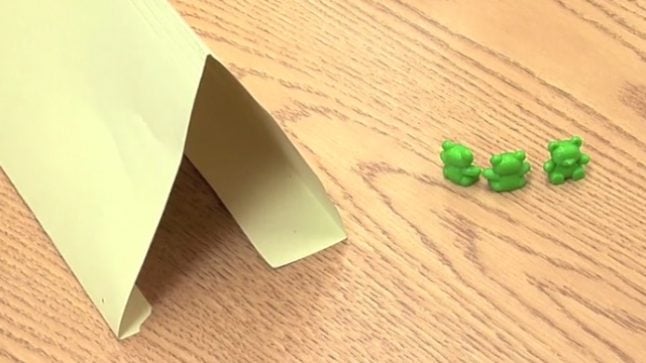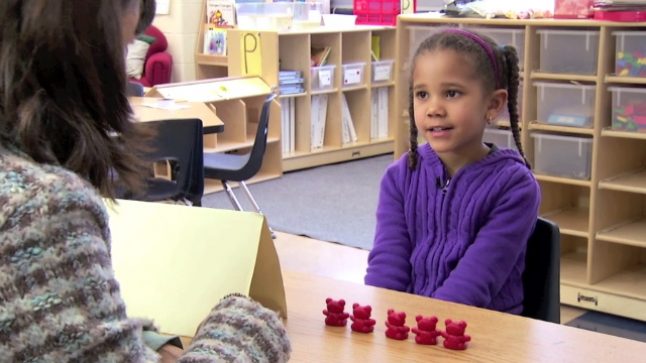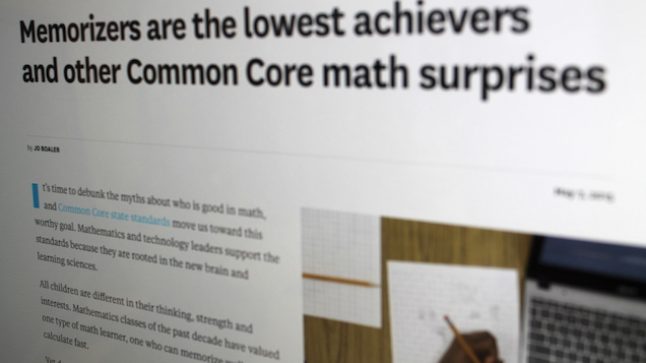Series: Focus on the Child
Matching Quantity with Child 3
June 11, 2015
A child produces a small set of counters to match a shown quantity.
- Topic: Number Sense
- Age/Grade Level: Pre-K
- Tags Subitizing, Child 3
Series: Focus on the Child June 11, 2015
Estimating Quantity with Child 3
A student approximates the number of cubes in collections of increasing quantity.
- Topic: Number Sense
- Age/Grade Level: Pre-K, Kindergarten
- Tags Estimation, Unifix Cubes, Comparing, Child 3
Series: Focus on the Child June 11, 2015
Estimating Quantity with Child 8
A child estimates the number of cubes in a collection.
- Topic: Number Operations
- Age/Grade Level: Pre-K, Kindergarten
- Tags Estimation, Unifix Cubes, Comparing, Child 8
Series: Focus on the Child June 11, 2015
Changing Quantity with Child 13
A student computes how many objects are in a collection that is hidden from view.
- Topic: Number Operations
- Age/Grade Level: Pre-K, Kindergarten
- Tags Animals, Child 13
Series: Focus on the Child June 11, 2015
Parts & Wholes with Child 29
A kindergarten student determines how many bears are in and out of their cave.
- Topic: Number Operations
- Age/Grade Level: Pre-K, Kindergarten
- Tags Animals, Child 29
Series: About the Collaborative May 27, 2015
Collaboration with the Ounce Highlights Math Development in Children Ages 0-3
Reading a "touch-and-feel" book or singing an action song with a baby or toddler is setting the groundwork for mathematical thinking and future school success. That's the point of Math All Around Me (MAAM), a joint…
Series: About Early Math May 26, 2015
Teaching STEM the Focus of 100Kin10 Summit
At the 100Kin10 Annual Summit, held at The Museum of Science and Industry in Chicago, education experts from across the nation gathered to discuss the topic of teaching STEM (Science, Technology, Engineering, and Math).
- Tags 100Kin10
Series: Hear from the Experts May 20, 2015
Developmentally Appropriate Practice Possible within Common Core
In this video from NAEYC (National Association for the Education of Young Children), Executive Director Rhian Evans Allvin describes their new white paper about developmentally appropriate practice within Common Core State Standards.
- Age/Grade Level: Adult Learners
- Tags Common Core, CCSS, NAEYC
Series: About Early Math May 13, 2015
Math Opportunities Hidden in Geocache App
Geocaching is an activity that uses the GPS technology on your mobile device to allow for some real-life treasure hunting. It can mathematize otherwise ordinary situations, as it allows children to interact with real-world maps.
- Topic: Spatial Relationships
- Age/Grade Level: Pre-K, Kindergarten, 1st Grade, 2nd Grade, 3rd Grade
- Tags Mapping, Technology, Nature
Series: About Early Math May 11, 2015
Rote Memorization Hinders Math Performance
Results from PISA suggest that the highest achievers are the students who view math as a set of large, connected concepts, while those who utilize rote memorization for math facts and procedures are the lowest-achieving.
- Age/Grade Level: Pre-K, Kindergarten, 1st Grade, 2nd Grade, 3rd Grade
- Tags Common Core, CCSS









